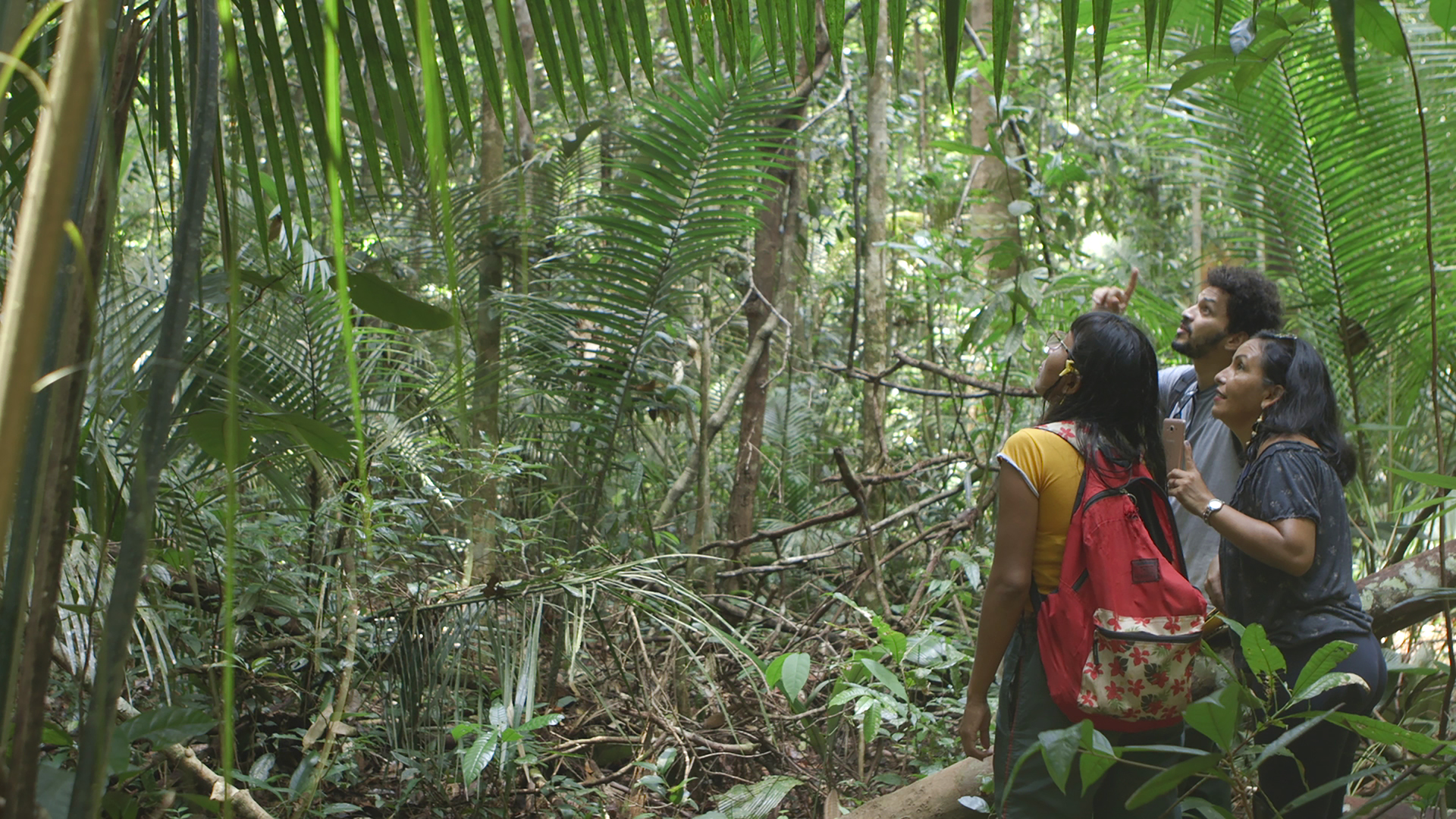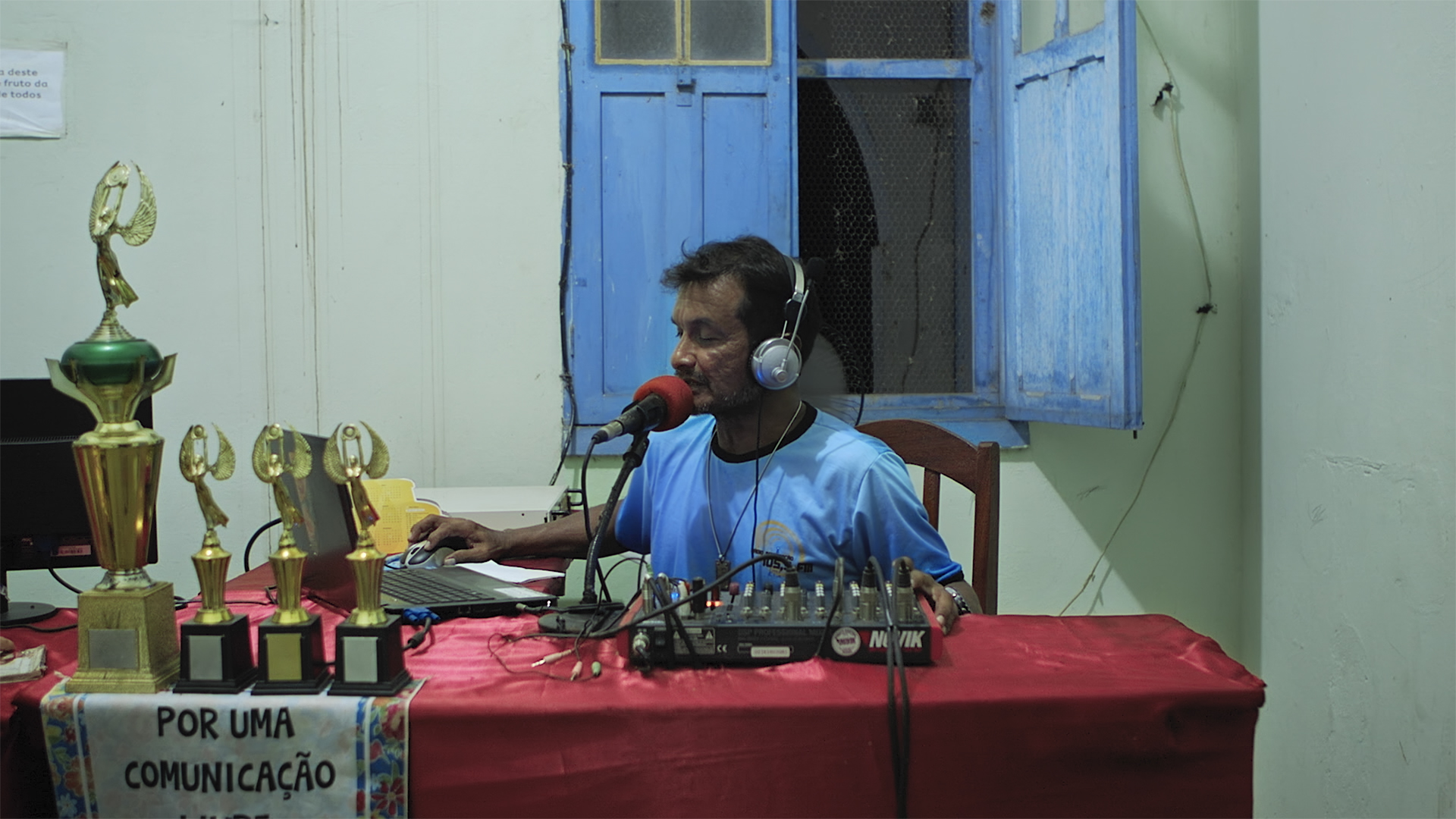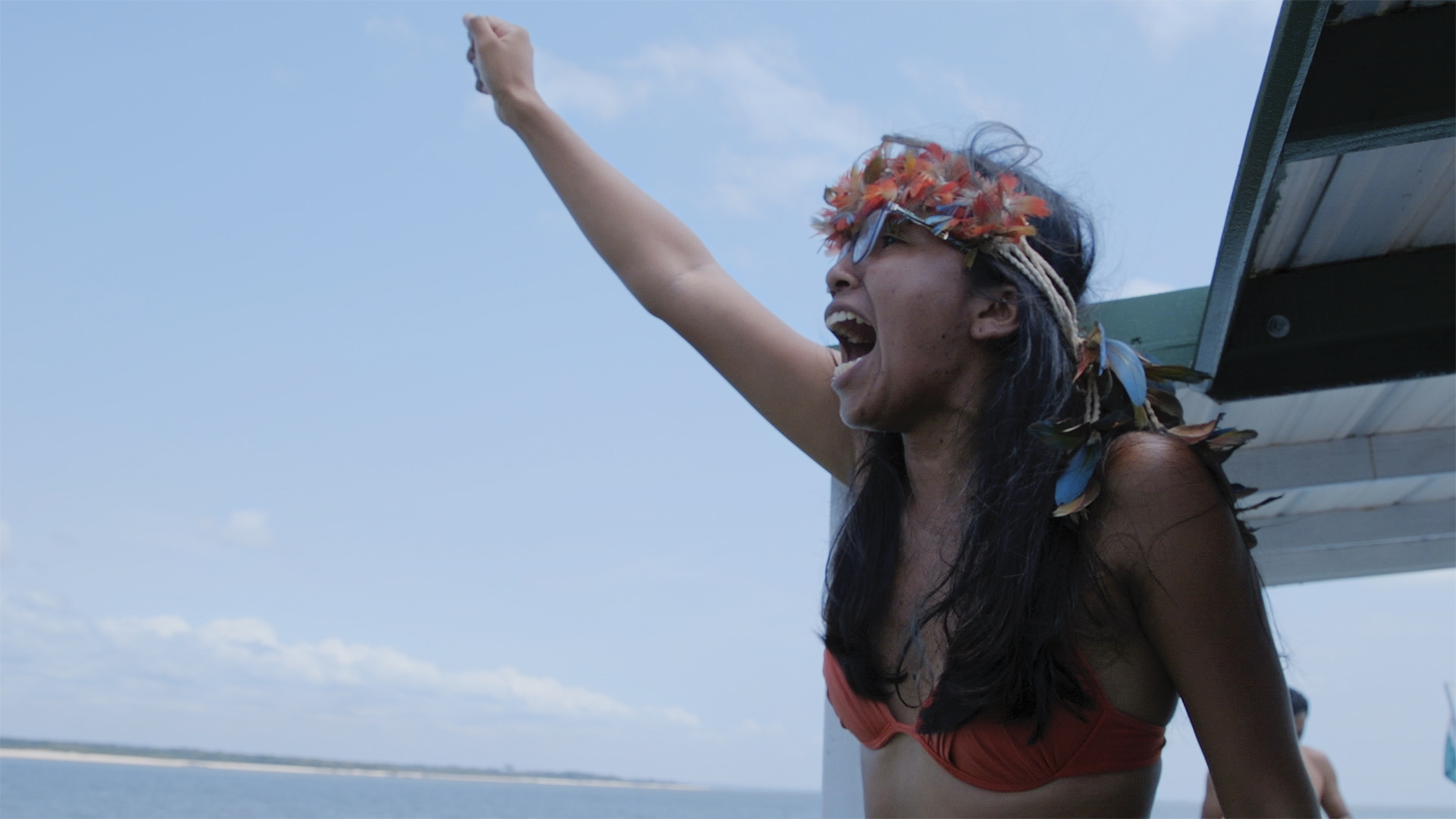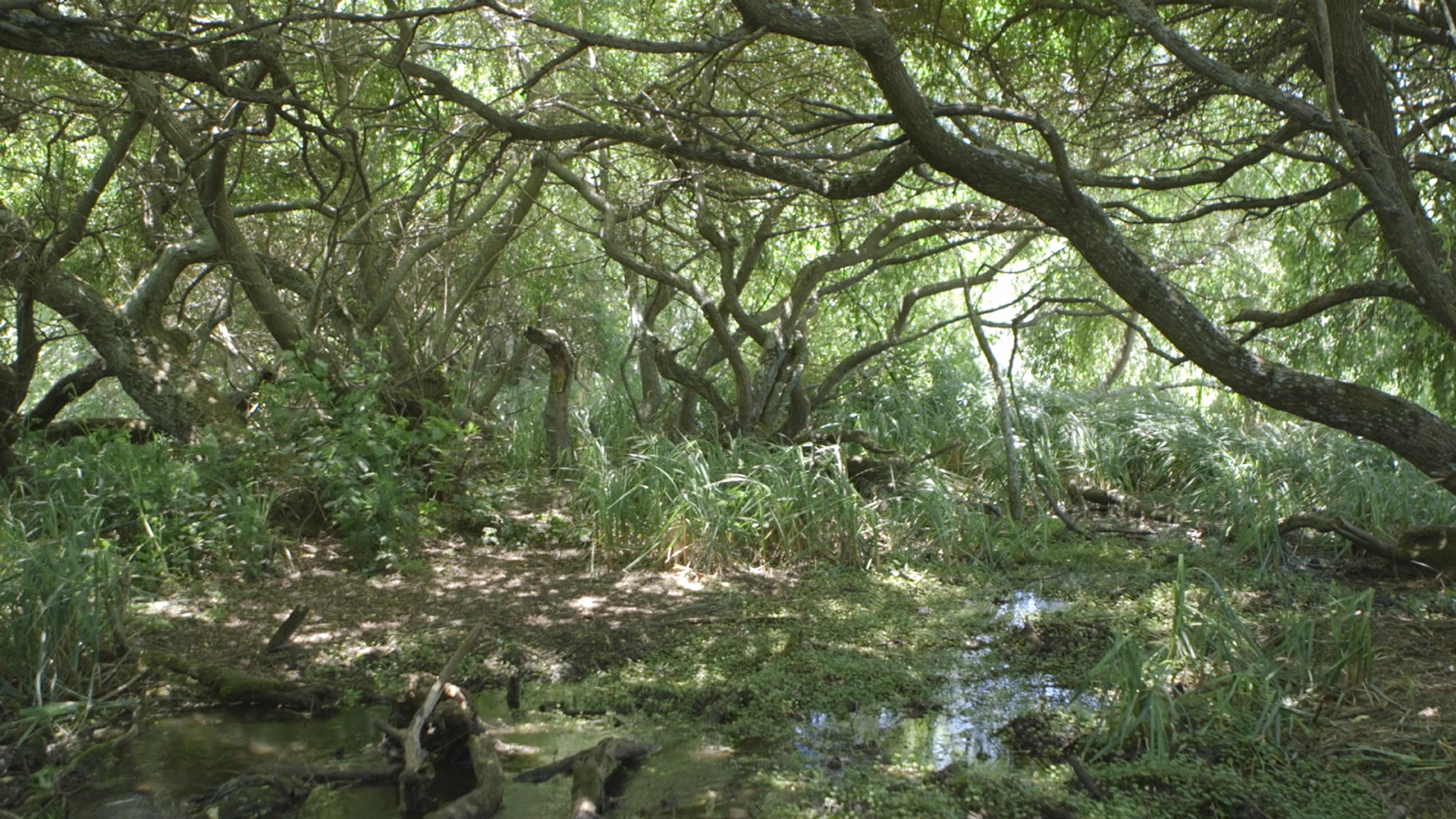SURARAS
2024, Brazil/Germany. Experimental documentary / video installation. Video, full HD, color, sound, 94’.
2024, Brazil/Germany. Experimental documentary / video installation. Video, full HD, color, sound, 94’.
Natalina Oliveira and Raquel Tupinambá are community broadcasters and grassroots activists from the state of Pará, in the middle of the Brazilian Amazon. They are residents of one of the oldest reservations in the region: the Resex Tapajós-Arapiuns land. Running an independent radio station, they create connections within their people and territory, but also between scientific and community knowledge. The two women are brave Amazonian guardians, known locally as Suraras. When they are invited to visit ATTO, the Amazon Tall Tower Observatory, the highest observation tower in the continent, they embark on an adventure through the rivers and the riverside communities of the largest tropical forest on the planet. Together with them, we connect with the lives, the stories, and the knowledge residing in this territory and its people. We learn about a place of plentiful biodiversity, but also of political struggle and resistance against large-scale extractivism. SURARAS is a documentary on the borders of artistic, scientific, global, and local practices.
World Premiere in September 2024 at the CineBH - Belo Horizonte International Film Festival.
Clipping:
O LIBERAL: CineBH recebe a produção amazônica: filmes paraenses ‘Sangria’ e ‘Suraras’ (includes an interview with Barbara Marcel)
Mídia Ninja: CineBH – Mostra Internacional de Cinema de Belo Horizonte anuncia a programação de sua 18ª edição
Max Planck Institute for Biogeochemistry: "Suraras" at the CineBH International Film Festival
ISTOÉ: Em sua 18ª edição, Mostra Internacional de Cinema de Belo Horizonte exibe 110 filmes





MARLENE
2022, DR Congo-Germany. Video, color, sound, approx. 46min
2022, DR Congo-Germany. Video, color, sound, approx. 46min
During an artist residency in the Democratic Republic of Congo, as part of the YANGO! biennial of visual arts, the German-based Brazilian filmmaker Barbara Marcel, proposes a workshop on Third Cinema for local students of the Kinshasa Fine Arts faculty. Among the films discussed by the group is "Der Leone Have Sept Cabezas" by Brazilian filmmaker Glauber Rocha, a key figure of the Brazilian New Cinema (Cinema Novo Brasileiro). Filmed in Congo Brazzaville in 1969, just across the river, the film is part of Glauber's Tricontinental Cinema project, elaborated between 1967 and 1975, by converging some of Rocha’s films and articles in the same direction and integrating political analysis, aesthetic renewal, and the creation of utopias of liberation of the so- called “Third World” countries. Marlene is the result of the screening and reception of Glauber's film today, the debates about militant cinema, the tricontinental project, and the new encounters produced in the Kinshasa workshop.





Film credits
WITH
Maité Moseka Botembe
Sephora Mianda
Pascoal Francisco Konde
Azgard Wenga Itambo
Wezam Moimi
WORKSHOP PARTICIPANTS
Dikamba Bénédicte
Moyo Merdie
Kasangati Daniel
Amanda Daniella-Richess
Ndungi Landry
Nzembeyo Emmanuel
Batupe Bryan
Holy Jonathan
Chris Shongo Loody
Bitshilualua Hancy
Samuel Mwani Ngange
Silas Nsilulu Nloko
Aris Likonda
John Dewitt Makengo
Joyce Lukoki Nsimba
Paulvi Ngimbi
Isaac Sahani Dato
DIRECTING AND IMAGE
Barbara Marcel
EDITING
Diogo Oliveira
SCRIPT
Barbara Marcel and Diogo Oliveira
DIRECT SOUND
John DeWitt Makengo
SECOND CAMERA
Azgard Wenga Itambo
SOUND MIXING
Thierry Bertomeu - Nova Pista
COLOR CORRECTION
Antoine d’Artemare
EDITING ASSISTANT
Beatriz Krieger
SET PRODUCTION AND TRANSLATION
Maité Moseka Botembe
Isaac Sahani
Paulvi Ngimbi
TRANSPORT AND GUIDE
Cedrik Tshimbalanga
SUBTITLES
John DeWitt Makengo
Paulina Hupe
Beatriz Krieger
PRODUCTION
Barbara Marcel
ASSOCIATE PRODUCERS
ifa - Institut für Ausländische Beziehungen
YANGO! Biennale
Matière Revue Studio
This film was produced during an artistic residency in Kinshasa, as part of the YANGO! Biennal of Arts.
YANGO! Biennale Team
Sara Alonso Gómez
Nadia Yala Kisukidi
Sinzo Aanza
Dada Kahindo
Isaac Sahani
Paulvi Ngimbi
Muriel Babandisha
Michel Mayoyo
Patrick Wassy
Wendy Bashi
Hélène Ballis
Robert Mumbala
Fragment of MESSAGE TO THE TRICONTINENTAL by Ernesto Che Guevara.
Speech given in Havana, April 16, 1967.
Extracts from the film DER LEONE HAVE SEPT CABEÇAS
by Glauber Rocha, Congo Brazzaville, 1970.
© Herdeiros de Glauber Rocha / Copyrights Consultoria
Music OXOSSI by Guga Stroeter.
THANKS TO
Ruy Gardnier
Lisette Lagnado
Luiza Prado
Felipe Frozza
Lydia Schellhammer
Christ Mukenge
Marian Kaiser
Astrid Matron
Hermani Heffner
Joyce Soares
Ava Rocha
Paloma Rocha
Juliana Perdigão
Jérôme Chazeix
Felipe Campos
VULTURE
20.04.2021-20.05.2021, Berlin. Artistic intervention on billboards at U1 Kottbusser Tor subway station (Kreuzberg - Berlin)
20.04.2021-20.05.2021, Berlin. Artistic intervention on billboards at U1 Kottbusser Tor subway station (Kreuzberg - Berlin)
SÜDSTELLIUM is a project conceived by Matheus Rocha Pitta, Ana Hupe and Barbara Marcel, which proposes transmissions and collaborations with artists based in Brazil. As a fruit of these dialogues, three images will occupy billboards of the U1 subway at the Kottbusser Tor station in Berlin between 20.04 and 10.05.2021.
In a dialogue with Vândria Borari, Barbara Marcel wonders how it is possible to imagine the sky of Alter do Chão from the city of Berlin.
What if to see the fallen skies of the Amazon one had to look at the soil, look at the clay and ceramics found on the shores of the Tapajós River? On a visit to the Berlin Ethnographic Museum in 2019, at the invitation of Barbara Marcel, the also artist, lawyer and indigenous activist Vândria Borari had for the first time contact with the collection of pre-Columbian art located in Berlin. Amidst the museum's large collection of South Amerindian pieces, Vândria encountered Tapajonic vases, amulets and ceramic fragments, material culture of her ancestors. The collage resulting from the dialogues between the two brings together one of the vases from Berlin's collection; drawings by German-Brazilian ethnologist Curt Niemuendajú of one of the oldest cave paintings in the Amazon, located at the archeological site of Monte Alegre, Pará; and a photograph by Barbara Marcel of vultures sunbathing on Carauarí beach in Alter do Chão. According to Tapajonic cosmology, vultures are animals capable of connecting the immanent world with the transcendental realm. Regarded as funerary agents in some cultures around the world, they continue to be important interspecies caretakers in the ecological balance of the Amazon biomes, as well as sacred animals for the Borari indigenous people. In the Tapajonic ceramic vase acquired by the Berlin Museum in 1932 by the museum's former director, art historian Erich Wiese, we see female figures of caryatid women supporting the base of the vase and vultures on top of the piece. The collaborative project between Vândria Borari and Barbara Marcel is part of a long-term project on Tapajonic ceramics in European museums and a film to come.








CINE LIANA
2020, Ciné-Cipó – Cine-Liana: ATTO – Amazon Tall Tower Observatory. Multichannel video installation, 126 min.
2020, Ciné-Cipó – Cine-Liana: ATTO – Amazon Tall Tower Observatory. Multichannel video installation, 126 min.
The artistic project Ciné-Cipó / Cine Liana at ATTO Tower (2020) shows in a video installation the production and exchange of different types of knowledge – scientific knowledge from the international scientific community as well as traditional knowledge of the people living in the Amazon rainforest. The largest tower in Latin America, the Amazon Tall Tower (ATTO), aims to study the interactions between the forest, soils and atmosphere of the region in order to understand the role of the Amazon basin for the Earth system. The tower is part of an international cooperation between Brazil and Germany, built and financed by INPA - Amazon Research Institute and Max-Planck Institute. For the project, the tower was temporarily occupied and transformed into a community radio under the command of Natalina Oliveira and Milena Raquel Tupinambá. Produced in collaboration with the ZKM - Zentrum für Kunst und Medien Karlsruhe for the exhibition "Critical Zones - Observatories for Earthly Politics", curated by Bruno Latour, Peter Weibel, Martin Guinar and Bettina Korintenberg, the project's proposal was to create a meeting between two popular radio communicators from Pará and research scientists from ATTO.

How is the scientific knowledge produced at ATTO democratized? How does this knowledge impact and dialogue with indigenous quilombolas and riverside communities? Making data accessible to the global scientific community is as challenging as communicating it to more people. The artist therefore proposes a collaboration between scientists and local radio communicators of Resex Tapajós-Arapiuns river. The scientific results and traditional knowledge are set in relation, forming an alliance for the defense of the Amazonian biodiversity. Atmospheric and earthly data are translated into popular communication via a radio show with spots, interviews and songs, what means a gesture of empowering of the local communities as the information gets distributed in an accessible way. During the process, scientific evidence and ancestral knowledges sometimes intersect, occasionally disconnect, while the scientific community listens and also learns more about the struggles in defence of the territories and local livelihoods of the Amazonian populations, demystifying universalizing assumptions. The dialogue between scientists and local inhabitants gets going in a transmission and acknowledgment of other than scientific forms of knowledge, addressing a core question of the actual debates around the environmental crisis we are living: How is the public debate about the socioenvironmental crisis conducted? Who speaks from which point and where do the different discourses enter into dialogue?
The 4-Channel installation is on display between Sat, 23.05.2020 - Sun, 09.01.2022 at the ZKM in Karlsruhe. A partial online version at the Critical Zones exhibition site can be accessed through the following direct link: https://critical-zones.zkm.de/#!/detail:cine-cipo-cine-liana-atto-amazon-tall-tower-observatory














Technical Specifications
Produced in collaboration with the ZKM | Karlsruhe
Barbara Marcel with Natalina do Carmo Oliveira, Milena Raquel Tupinambá
Presenting Natalina do Carmo Oliveira, Milena Raquel Tupinambá; Direction and Production: Barbara Marcel; Image: Felipe Frozza, Barbara Marcel; Direct Sound: Anne Santos; Set Production: Kandyê Medina, Thais Helena Medeiros, Bruna Bichara; Editing: Célia Freitas, edt.; Editing Assistance: Beatriz Krieger, Felipe Frozza; Sound Mixing: Sarah Lelièvre; Colorist: Guilherme Begué; Finishing Editor: Beatriz Krieger; Music: Suraras do Tapajós
Funded by: Instituto Serrapilheira, Max Planck Institute for Biogeochemistry Jena
Supported by: INPA-National Institute of Amazonian Research, Goethe-Institut São Paulo, Casa Bicho
The ATTO project is funded by: German Federal Ministry of Education and Research (BMBF), Brazilian Ministry of Science, Technology and Innovations, Max Planck Society, Finep, Fapeam, and Fundação Eliseu Alves.



HUMO SOBRE HUMEDALES
2019-21, Chile. Video, color, sound, approx. 90min.
2019-21, Chile. Video, color, sound, approx. 90min.
Following the work of environmentalists and communicators involved in social movements in the city of Concepción, the video portrays the role of women in the uprising that took to the streets of Santiago and all the cities of Chile between October and December 2019. HUMO SOBRE LOS HUMEDALES takes as a starting point the defense of local wetland ecosystems called Humedales – interconnected hydrological systems with a transitional morphology between land and water –, and shows how environmental struggles are indissociated from social mobilizations for basic rights such as access to clean water. The video depicts transmissions by a local Community Radio and the Latin American Ecofeminist debates during the Carpa de las Mujeres in Santiago, a meeting parallel to the Climate Conference 25 in Madrid 2019. Narrated with the artist's voice off in the tone of a travel diary, the film contrasts the individual gaze and the many voices of the crowd clamoring for a new national constitution.
The video was produced in Laguna Grande de San Pedro, Concepción and Santiago de Chile between November 18 and December 17, 2019. The project is the result of the Artistic Residence ARTIVISM, initiated by the Goethe Institute Chile and Galeria Metropolitana in Santiago. Supported by Kummer-Vanotti Stiftung.










Film credits
With
Radio Humedales: Paloma Bello, Carla Duran, Alejandra Fuentes, Pierina Pondanelli, Paula Sepulveda, Katherina Venegas
Red Humedales Bío Bío: Jo Varela, Luisa Valenzuela (La Guardiana), Eve Soto
March at the International Day for the Elimination of Violence Against Women in Concepción, 25.11.2019
Chilean collective "Las Tesis", at the a performance "Un violador en tu camino"
Women participanting in the Cumbre de los Pueblos y Carpa de las Mujeres, 2-6.11.2019 at the Escuela de Artes y Oficios (OEA) of the Universidad de Santiago de Chile:
Speakers (in order of appearance): Juana Vera, Francisca Rodríguez, Yayo Herrero
Production, Camera, Editing
Barbara Marcel
Research, Set Production
Ana Maria Saavedra and Flavia Hechen
Editing Assistance, Subtitling
Beatriz Krieger
Drone Images
Nicolas Salazar
Sound Design and Mix
Sarah Lelièvre
Original Soundtrack
Lea Taragona
Audio Excerpts
AOIR Cartografía Sonora - Octubre (Chile Despertó), Valentina Villarroel
Radio Humedales
Podcast Cacerola Informativa #DespertamosdelShock - Episodios 30.10 / 03.12 / 06.12.2019
Music
Humedales la cabeza a los pájaros, Fabiano-Kueva y Valentina Villarroel
Grabaciones de campo/Cerro caracol, Valentina Villarroel
Nos tienen miedo, Liliana Felipe (Mil Veces Mil, 2008)
Contra Todo, iLe (Almadura, 2019)
Las Golondrinas, Evelyn Cornejo (La Chusma Inconsciente, 2017)
Octubre 19, Indomitamorfosis (2019)
Supported by Goethe Chile, Galeria Metropolitana, Kummer-Vanotti Stiftung.